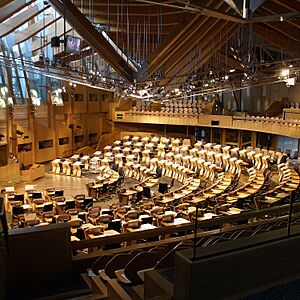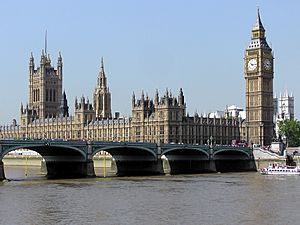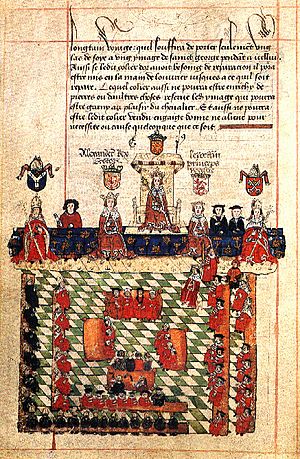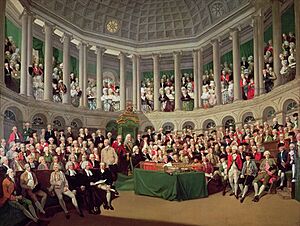Parliament of the United Kingdom facts for kids

The Parliament of the United Kingdom is the most important law-making group in the United Kingdom and its overseas territories. It has the main power over all other political groups. At its head is the Monarch, currently Queen Elizabeth II.
Parliament has two main parts: the House of Lords (the upper house) and the House of Commons (the lower house). The Queen is also a key part of Parliament.
Parliament started a long time ago. It grew from old councils of bishops and nobles who gave advice to the kings and queens of England.
Contents
How the UK Parliament Works
The Parliament of the United Kingdom has three main parts. These are the House of Commons, the House of Lords, and the Monarch. Most of the power to make laws is held by the House of Commons.
The House of Commons has 650 Members of Parliament (MPs). People in the UK vote for these MPs to represent them. The leader of the political party with the most MPs usually becomes the Prime Minister. The Prime Minister leads the government, but the Monarch is the Head of State.
The House of Commons usually starts new laws, called Bills. They also decide on taxes. The House of Lords can check these Bills and ask the Commons to think about them again. However, they cannot stop money Bills. If the Lords reject a Bill twice or delay it for over a year, the House of Commons can still pass it. This is thanks to special rules called the Parliament Acts.
The Monarch (now HM Queen Elizabeth II) is the head of the country in a system called a constitutional monarchy. This means the Monarch has some powers, but they are mostly used on the advice of the Prime Minister. For a Bill to become a law, the Monarch must give it their Royal Assent. The Monarch also calls Parliament together, pauses its work, and ends it. It is very rare for the Monarch to say no to a Bill today.
How a Bill Becomes a Law
New laws, called Bills, can start in either the House of Commons or the House of Lords.
Pre-legislative Scrutiny: Sometimes, a special group of people from both houses looks at a Bill before it is officially started. They suggest changes, which the government can accept or reject.
![]() First Reading: The Bill is introduced. No vote happens yet. It is just printed and a date is set for its next step.
First Reading: The Bill is introduced. No vote happens yet. It is just printed and a date is set for its next step.
![]() Second Reading: Members debate the main ideas of the Bill. After the discussion, they vote on whether to continue with it.
Second Reading: Members debate the main ideas of the Bill. After the discussion, they vote on whether to continue with it.
Committee Stage: A smaller group of members looks at each part of the Bill very closely. They can suggest changes, called amendments.
Report Stage: This is a chance for the whole House to look at the Bill again. They can discuss and vote on any changes suggested by the committee.
![]() Third Reading: Members debate the final version of the Bill after all changes have been made. In the House of Lords, more changes can still be made at this point.
Third Reading: Members debate the final version of the Bill after all changes have been made. In the House of Lords, more changes can still be made at this point.
Passage to the Other House: Once one House approves the Bill, it is sent to the other House. The same steps (First Reading, Second Reading, Committee Stage, Report Stage, Third Reading) happen there.
Return to Original House: If the second House makes changes, the Bill goes back to the first House. They look at all the suggested changes.
Royal Assent: If both Houses agree on the Bill, it is sent to the Monarch. If the Monarch gives their Royal Assent (approval), the Bill officially becomes an Act of Parliament, which means it is now a law.
History of Parliament
In the Middle Ages, there were three kingdoms in the British Isles: England, Scotland, and Ireland. Each of these had its own parliament.
In 1707, the Acts of Union joined England and Scotland. They then shared one Parliament called the Parliament of Great Britain. Later, in 1800, the Act of Union included Ireland. This created the Parliament of the United Kingdom. The Parliament building in Westminster in London is sometimes called the "Mother of all Parliaments."
English Parliament
The English Parliament began with an old Anglo-Saxon council called the Witenagemot. After William of Normandy took over in 1066, he asked for advice from a council before making laws.
In 1215, this council made King John sign the Magna Carta. This important document said that the king could not collect new taxes without the council's agreement. This council slowly grew into what we now call Parliament.
In 1265, a man named Simon de Montfort called the first Parliament where people were elected. Later, in the 1500s, laws joined Wales with England. This meant Welsh representatives could join the English Parliament.
When Elizabeth I died in 1603, the Scottish King James VI of Scotland also became King of England (James I). Both countries were under his rule, but they each kept their own Parliament for a while.
Scottish Parliament
In Scotland, the King's Council of Bishops and Earls started to become the Parliament around 1235.
Irish Parliament
The Irish Parliament was created to represent the English people living in Ireland. The first known meeting was in 1264. At first, native Irish people were not allowed to vote or be part of it.
In 1541, Henry VIII declared the Kingdom of Ireland. After this, Irish lords were allowed to attend the Irish Parliament as equals.
Images for kids
-
Print of the Palace of Westminster, before it burnt down in 1834
-
Leading 17th century Parliamentarian John Hampden is one of the Five Members remembered each year.
-
Parliament meets in the Palace of Westminster.
-
Parliament Buildings, Stormont, Northern Ireland is home to the Northern Ireland Assembly.
See also
 In Spanish: Parlamento del Reino Unido para niños
In Spanish: Parlamento del Reino Unido para niños








